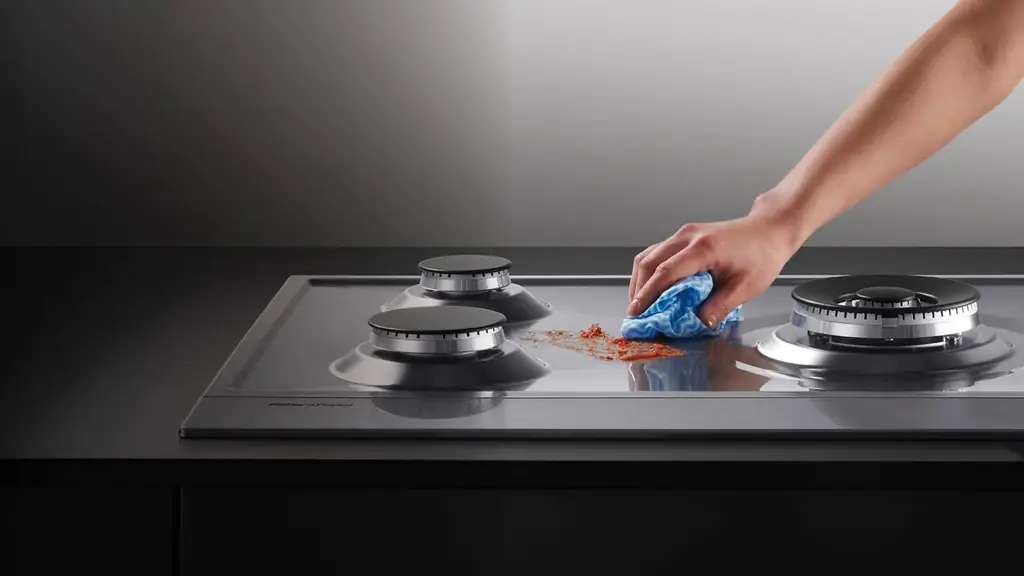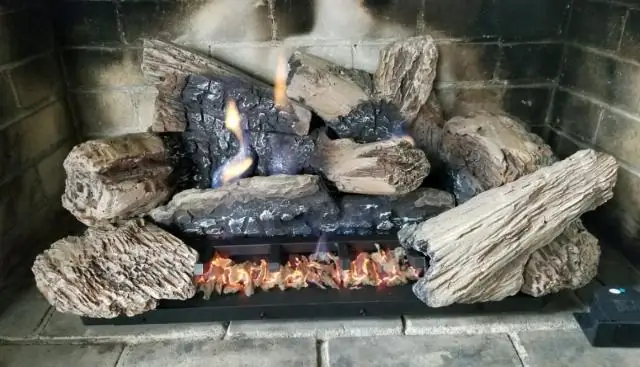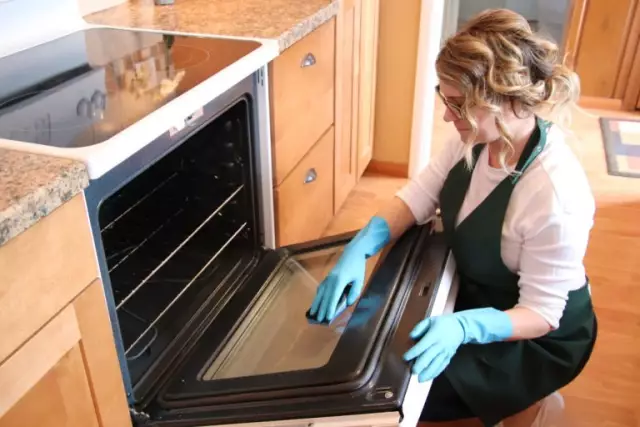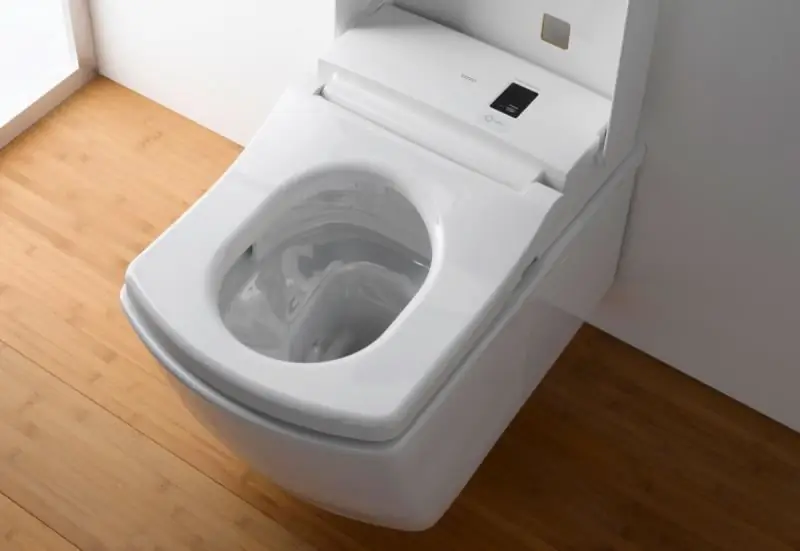
Table of contents:
- Author Bailey Albertson [email protected].
- Public 2024-01-07 21:36.
- Last modified 2025-01-23 12:41.
Without the help of a chimney sweep: how to properly clean the chimney

Stove heating does not lose its popularity and relevance in the modern world. Prices for utilities are growing by leaps and bounds, so having an autonomous heater is great to save on bills. A stove is not only a high-quality heating system, a stove for cooking, an extra bed and an original and authentic interior decoration, but also a chimney. Any chimney becomes clogged with soot and soot over time. To avoid an emergency, it is necessary to periodically take measures to clean the chimney. This can be done in three ways: mechanical, chemical and folk.
Content
-
1 Reasons for the formation of soot in the chimney
- 1.1 Table: heating value of different wood species
- 1.2 Video: how soot is formed in the chimney
-
2 How to clean the chimney
-
2.1 Mechanical method of chimney cleaning
- 2.1.1 Chimney cleaning tools
- 2.1.2 Table: how often to clean the chimney
- 2.1.3 How to carry out mechanical cleaning
- 2.1.4 Video: how to clean the chimney with your own hands
-
2.2 Chemical method of chimney cleaning
2.2.1 Video: how the chemical method of cleaning chimneys works
-
2.3 Folk remedies for cleaning the chimney: time-tested
1 Video: Chimney cleaning with potato peelings
-
- 3 Once again about chimney prevention
Reasons for the formation of soot in the chimney
It is impossible to operate the stove without the formation of soot. The deposits are deposited on the inner walls of the chimney due to the complex chemical processes that occur during the combustion of any type of fuel - from solid to liquid.

When any fuel, including firewood, burns, soot settles on the walls of the chimney
Liquid fuel (gasoline, kerosene) is rarely used in home stoves. This is, firstly, dangerous, and secondly, impractical: it is expensive, burns out quickly. Firewood is used for the firebox. They can be made from different types of wood. An experienced owner knows: not all breeds are suitable for high-quality kindling of the stove. Some burn too quickly, others burn poorly, and others are not able to heat the stove well.
What kind of wood to choose? Those with a high calorific value.
Table: Calorific value of different wood species
| Tree |
Calorific value (kcal / m 2) |
| oak | 324 |
| ash | 300 |
| Rowan | 295 |
| beech | 275 |
| elm | 265 |
| larch | 265 |
| Birch | 260 |
| cedar | 230 |
| alder | 200 |
| aspen | 190 |
Conifers are the least suitable for the furnace. They form too much soot, but their calorific value is at the lowest level.

There is a lot of resin in coniferous firewood, so when they burn, a thick layer of soot forms
Video: how soot forms in the chimney
youtube.com/watch?v=L4siaOS0zJE
How to clean a chimney
The chimney does not need to be cleaned every day. This is done as carbon deposits form: from once a month to once every six months. If it is difficult to cope on your own, then it is better to hire an experienced chimney sweep.

The profession of a chimney sweep in our time is a thing of the past, it is very difficult and expensive to find a good specialist
But it's cheaper to do it yourself. To do this, you just need to choose a cleaning method:
- mechanical;
- chemical;
- folk.
If the carbon deposits are very dense, then the mechanical method is necessarily combined with the chemical or folk method. Using all three methods at the same time is simply impractical.
Mechanical method for cleaning the chimney
This method can be called the most time consuming. For its implementation, you need special equipment (tools) and the absence of fear of heights. It is also necessary to comply with the following conditions:
- work only in dry, calm weather;
- wear non-slip shoes;
- take care of good insurance;
- pre-study the basics of chimney sweeping with the help of videos and articles;
- consider securing the tool before loading it into the pipe.
To mechanically clean the chimney:
- Climb onto the roof.
- Remove the cap or umbrella from the pipe.
- Immerse the tool inside the chimney.
- Carefully, using a lot of effort, scrape off the carbon deposits from the walls.
You need to work consistently, without haste.

It is necessary to clean the pipe without haste, excessive agility here can only harm
All the soot will crumble down, so it is important to take care of the furniture and equipment in the room in advance: cover them with cellophane or cloth. If possible, the floor should also be covered - soot elements are difficult to remove from its surface.
Chimney cleaning tools
A good chimney sweep doesn't need a lot of tools to get the job done. This is elementary inconvenient: with a large number of items to perform the procedure, it is difficult to climb onto the roof and stay there for a long time.
What exactly is needed to clean the chimney:
-
Core. Without it, it is impossible to break through the blockage, otherwise there will be no point in further cleaning. The kernel is used regularly, it is not always possible to determine by eye whether there is a jam. It is made of cast iron or metal, filled with sand for weighting, and is tied or welded to a chain that ends with a handle. For her, the chimney sweep holds this tool during manipulations.

Cast iron core The cast iron core quickly removes the blockage in the pipe due to its weight
-
Stiff brush with a long handle. The villi should be made of metal or hard plastic. The first option will clear up the blockage faster, but is not suitable for stainless steel interior walls. Plastic is considered a more gentle material, but it will take much longer to remove carbon deposits.

Chimney brush The material from which the brush fibers are made is selected depending on the type of chimney
-
Long handled scraper. It is usually used after a brush to completely remove soot from the walls. Made of metal or plastic.

Chimney scraper Removing soot residues with a scraper completes the chimney cleaning process
There are universal tools on the market that combine a scraper and a brush or a scraper and a core
You can make any of the tools yourself. You can use the shaft of a shovel or mop as a handle. But the kernel, if possible, is better to buy in a specialized store. Although any heavy object can be used for punching (for example, an old cast iron or frying pan), only the core is guaranteed not to get stuck inside the chimney due to its "anatomical" features.
Table: how often to clean the chimney
| Event | Regularity |
| Checking a chimney that is operated seasonally | Before the season starts |
| Checking a chimney that works regularly | Once in three months |
| Chimney cleaning once a season | At the end of the season |
| Cleaning a regularly used chimney | At least once every three months |
| Cleaning when operating in harsh winter conditions (when the air temperature drops to -40 o C) | At least once a month |
| Chimney sweeping if there is a possibility that birds can make a nest in or at the end of the pipe | As needed |
How to carry out mechanical cleaning
In order to qualitatively clean the chimney from soot using purchased or self-made tools, it is advisable to adhere to the universal instructions, which involves the following actions:
- Close the inspection hatches, which are usually supplied to any chimney.
- Cover the hearth with a wet cloth to prevent the soot from falling to the floor and onto the furniture.
- Cover the floor, furniture and appliances with cloth or cellophane so that traces of soot do not settle on furnishings.
-
Put on work clothes, wear protective gloves, goggles, provide fall protection and climb onto the roof.

Safety measures when cleaning the chimney Cleaning should be done in work clothes, while it is worth taking care of insurance and gloves, you can wear glasses and a hat
-
Remove the umbrella or cap from the pipe, carefully put it next to the chimney so as not to drop it down.

Chimney deflector An umbrella or deflector is usually installed on the head of the chimney; before cleaning, it must be carefully removed and placed next to it, making sure that it does not fall
-
Lower the core into the tube. If the tool passes easily, it means that the blockage is broken or not at all. You need to work with the core until it begins to walk freely inside the pipe to the right and left, up and down.

Clean chimney In a clean chimney, the core moves easily without touching any obstacles
-
Clean the walls with a brush. It is moved up and down, right and left, but not chaotically, but consistently along all the walls of the chimney.

Cleaning the chimney with a brush With a brush, you need to go through each wall of the chimney, trying not to miss any of its sections
- Perform final scrubbing. It is only moved up and down.
- Inspect the revision chambers for soot.
It is impossible to get rid of the whole chimney soot. Only washing with soap and water will help. But it is unrealistic to perform this procedure at home, and it is not required. Mechanical cleaning of soot is stopped when large and small layers cease to separate from the walls.
Video: how to clean a chimney with your own hands
Chemical method of chimney cleaning
You can clean the chimney using household chemicals. It is easy to find special mixtures in stores that minimize the formation of carbon deposits in the pipeline. Manufacturers assure that "chemistry" will get rid of the already existing layer of soot in no time.
Do not believe the advertisements, it will not help if the carbon layer in the chimney is more than a centimeter thick. But in this case, the chemical method will serve as an excellent prophylaxis after mechanical cleaning of the chimney from above.
The essence of the chemical method for cleaning the chimney is as follows: the agent in the form of a powder is scattered on the wood, smoke is emitted during combustion, which does not allow soot to settle on the walls and dissolves the existing plaque.
The most popular pipeline cleaning chemicals are:
- "Smoke". Domestic drug is inexpensive, easy to use. It is a piece of wood that is put into a firebox with burning wood. Burns with a blue flame for an hour and a half. To clean and prevent the chimney, it is necessary to burn one log at each procedure;
-
HANSA. Lithuanian remedy popular in Russia. It is a powder in a tube that must be scattered over burning wood. You need to use the tool regularly, pouring 200 grams of powder for each ton of firewood;

Chimney cleaner HANSA HANSA powder should be used regularly, one pack is enough for 5 tons of firewood
-
"Chimney sweep". One of the most popular products for dry cleaning of chimneys. It is produced in the form of bars, looks like a log, is burned together with firewood in the firebox. The log burns for an average of 2 hours, but continues to operate for two weeks after burning, actively destroying soot;

Log "Chimney sweep" Chimney sweep log works for two weeks after burning, softening and removing soot build-up on the chimney walls
- Kominichek. The product is produced in the Czech Republic. The drug is packaged in sachets of 5 grams each. When the oven is already heated, the powder is added to the fire. At the same time, soot burns out at a lower temperature than in the firebox, so this method is absolutely safe and quite effective.
All these tools work according to the same principle. You need to add them to the fuel during combustion or just before ignition. Otherwise they will not work. All application information is indicated on the packaging. Chemistry can be dangerous for people: care must be taken to ensure that the bags of dry mixture do not fall into the hands of small children. During chemical cleaning, it is advisable to leave the room until the fuel has completely burned out.
Video: how the chemical method of chimney cleaning works
Folk remedies for cleaning the chimney: time-tested
Many are simply afraid of household chemicals: they are dangerous if used unwisely or stored improperly. To purchase them, you have to fork out - the plaque will not go away at once.
It is more budgetary and easier to clean using folk methods:
- cleaning with boiling water. Freshly boiled water is poured into the pipe from the roof, the soot instantly appears below. This method will help when the carbon layer is small;
-
cleaning with salt. A pack of salt (200-300 grams) is poured onto the wood and set on fire. Salt vapors effectively remove deposits in the pipe;

Salt Ordinary salt must be poured onto the wood, and the chimney will be cleaned.
- burning of naphthalene. The “smell” method. To get rid of carbon deposits, only one tablet is required, thrown into the fire. As a bonus - the destruction of insects within the entire premises;
-
peeling with potatoes or peeling them. A bucket of potato peelings or finely chopped young potatoes are poured into the firebox at the very end of the wood burning process. Starch helps to remove even thick soot layers;

Potato peelings Potato peelings remove even thick deposits
- breaking through blockages by means of copper sulfate, saltpeter and coal in powder. All this is mixed in a ratio of 5: 7: 2. Method of application - pouring into fire;
-
burning alder and aspen firewood. The procedure will require several kilograms of firewood - from 3 to 5.

Alder firewood Alder and aspen firewood has a very high combustion temperature, so the soot will simply burn out when used.
Video: chimney cleaning with potato peelings
Once again about chimney prevention
It is better to eliminate any problem with the chimney, including the formation of burning, at the initial stage of its occurrence, otherwise you will have to spend a lot of time and effort to eliminate the trouble.

Any chimney requires regular maintenance to prevent soot formation
As for prevention, it can be like this:
- check the chimney for birds or rodents;
- constantly remove wet fallen leaves from the chimney (if tall trees grow over the chimney);
- clear blockages as they form. Often the owners do not pay enough attention to this issue, so the carbon layer is constantly increasing, and it becomes difficult to remove it;
- do not burn household waste in the oven - it is wiser to dispose of it, for example, in a container;
- do not burn damp or soaked wood.
Not everyone knows, but carbon deposits in the chimney are extremely dangerous. Carbon monoxide will eventually cease to come out completely, part of it will remain in the room.

Chimney soot can cause fires, so be very careful and clean the chimney regularly.
Carbon monoxide is terrible for humans. Even a ten-minute inhalation of it can be fatal. Soot can provoke a fire when bits of it are thrown out of the chimney by the force of the smoke. The coal will easily fly to the neighboring building - the fire will be inevitable.
Any chimney, even a rarely used chimney, sometimes needs to be cleaned of soot. You can do the procedure yourself. To do this, you can use the mechanical, chemical or folk method. Methods of dealing with carbon deposits can be combined, but it is not recommended to use all three at once - this is simply not necessary. The more often the stove is heated, the more often the chimney needs cleaning. Each owner should have a core and a brush to get rid of carbon deposits from the pipe. They are sold in the store or made independently from scrap materials (old shovels, mops, brushes).
Recommended:
How To Clean A Gas Stove (grate, Burners, Pens, Etc.) With Folk Remedies (soda, Ammonia) And Not Only

Practical advice on cleaning a gas stove from grease and dirt. Folk remedies for cleaning surfaces, handles, burners and oven
Do-it-yourself Chimney Cleaning Using Potato Peelings, A Chainsaw And Other Methods, Including Folk, Instructions With A Video

You can maintain the chimney in the house yourself without resorting to the services of specialists. We will tell you how to clean the chimney with your own hands
How To Clean A Stove With Your Own Hands - Repair, Cleaning A Brick Russian, Bath, Round Stove From Soot Without Disassembling Why It Does Not Heat Well, Reasons, Cleaning Wells, G

How to repair and clean the oven with your own hands. Types of repair, when and why you need it. List of necessary tools and nuances to consider
How To Clean The Toilet From Urinary Stones At Home, How Can You Remove Plaque Inside (including Using Folk Remedies)

Where urinary calculus forms, the most effective ways to clean it from the toilet at home, photos, videos and tips for preventing the formation of growths
Baby Heels: How To Clean At Home, Including Folk Remedies

How to exfoliate your feet. Professional, folk and mechanical methods. What can not be treated with feet
